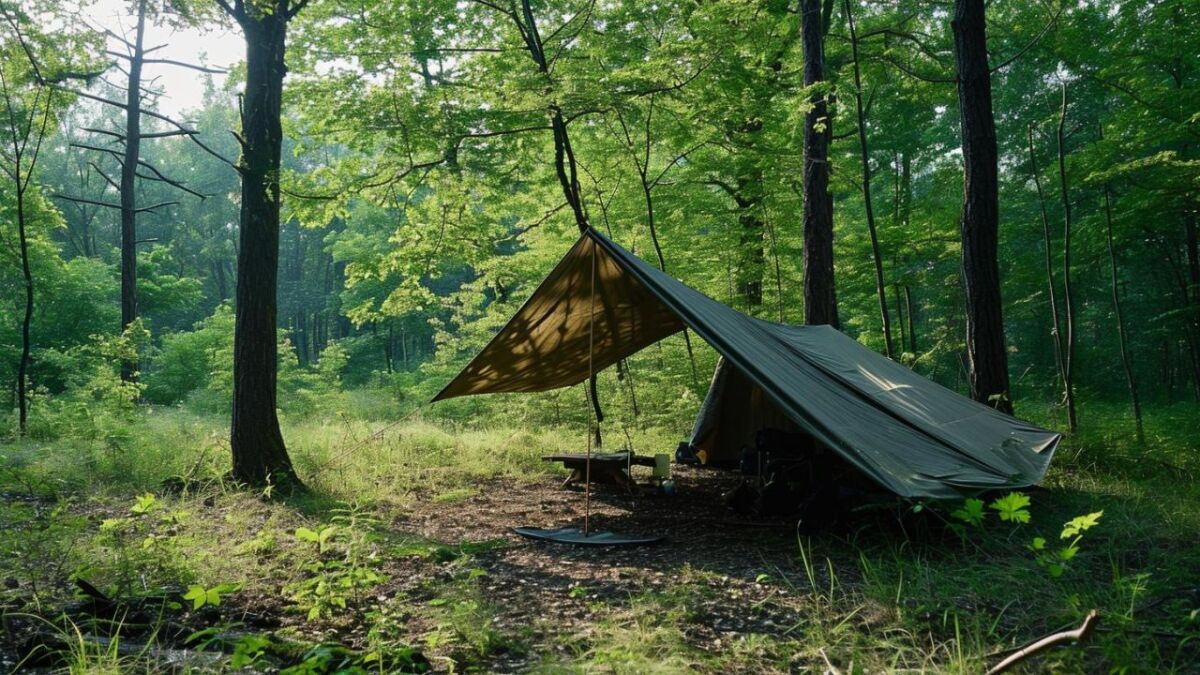
Tarp
Noun
Meaning
A tarp is a versatile piece of outdoor equipment that is commonly used in survival, bushcraft, camping, and hiking. It is a large sheet of waterproof fabric, usually made of nylon or polyester, that can be easily set up to provide shelter from the elements. Tarps are lightweight, compact, and easy to carry, making them an essential item for outdoor enthusiasts. They can be used to create a makeshift tent, protect gear from rain, provide shade, or even as a ground cover. With their multiple uses and practicality, tarps are a must-have for anyone venturing into the great outdoors.

Examples
„I love using a tarp when I go camping. It provides great shelter from the rain and keeps me dry and comfortable.“
„During my last hiking trip, I set up my tarp between two trees to create a cozy outdoor living space.“
„My friend and I were discussing our camping gear, and he mentioned how versatile a tarp can be. He uses it as a groundsheet, a makeshift tent, and even as a rain cover for his backpack.“
„When I go on a survival expedition, I always make sure to pack a tarp in my backpack. It's lightweight and easy to carry, making it an essential item for creating emergency shelters.“
„I recently watched a YouTube video where a bushcraft expert demonstrated different tarp configurations for various weather conditions. It was fascinating to see how a simple tarp can be transformed into a functional and protective shelter.“
Origin
The word "tarp" is a shortened form of the term "tarpaulin." The term "tarpaulin" originated in the 17th century and is derived from the combination of two words: "tar" and "palling." "Tar" refers to the sticky substance derived from the distillation of wood or coal, while "palling" is an old English word meaning "covering" or "cloth."
Tarpaulins were initially used as protective coverings for ships and their cargo. The tar coating made the fabric waterproof and resistant to the elements. Over time, the term "tarpaulin" was shortened to "tarp" and became more commonly used.
In the context of survival, bushcraft, and outdoor activities, a tarp refers to a lightweight, versatile, and durable piece of fabric that can be used for shelter, protection, and various other purposes. Tarps are often made from materials such as nylon or polyester, which are lightweight yet strong enough to withstand harsh weather conditions.
The use of tarps in outdoor settings has evolved over time, with different designs and configurations being developed to suit specific needs. Tarps can be set up as makeshift shelters, rain covers, ground sheets, or even used for creating improvised backpacks or carrying systems.
Today, tarps are an essential part of any survival kit or outdoor gear collection. Their versatility, portability, and ease of use make them a valuable tool for anyone venturing into the wilderness or engaging in outdoor activities.
Historical and cultural importance
The word "tarp" is short for "tarpaulin," which refers to a heavy-duty waterproof fabric that is commonly used in outdoor activities and survival situations. The historical and cultural relevance of tarps can be traced back to their origins in the maritime industry.
In the past, tarps were primarily used as protective coverings for ships and cargo. Sailors would use tarps to cover their goods and protect them from the elements during long voyages at sea. This practical use of tarps eventually extended to other industries, such as construction and camping.
Today, tarps are widely used in the world of bushcraft, survival, and outdoor adventure. They have become an essential piece of equipment for campers, hikers, and survivalists due to their versatility and durability. Tarps can be used to create shelter, provide shade, collect rainwater, and even as makeshift stretchers or carrying devices.
Furthermore, tarps have also gained cultural significance in the world of bushcraft and survival. They symbolize self-reliance, resourcefulness, and the ability to adapt to challenging environments. Many survival experts and enthusiasts consider tarps as a fundamental tool in their kit, as they provide a lightweight and effective solution for creating shelter and protecting oneself from the elements.
Overall, the historical and cultural relevance of tarps highlights their importance in outdoor activities and survival situations. Whether you're camping in the wilderness or preparing for a potential emergency, having a tarp in your gear can greatly enhance your chances of staying safe and comfortable in the great outdoors.
More information about the term Tarp
What is a Tarp?
A tarp, short for tarpaulin, is a versatile and essential piece of equipment for outdoor enthusiasts, survivalists, and bushcrafters. It is a large, waterproof sheet made of durable material, typically canvas or nylon, that is used to provide shelter and protection from the elements.
Uses of a Tarp
A tarp can be used in a variety of ways, making it a valuable tool in the wilderness. Here are some common uses:
1. Shelter: One of the primary uses of a tarp is to create a shelter. By tying the corners to trees or using poles, you can quickly set up a makeshift tent or lean-to. This provides protection from rain, wind, and sun, keeping you dry and comfortable.
2. Ground Cover: When camping or sleeping outdoors, a tarp can be spread on the ground to create a barrier between you and the damp or cold surface. This helps insulate your body and prevents moisture from seeping into your sleeping bag.
3. Rain Protection: If you're caught in a sudden downpour, a tarp can be used as a raincoat or poncho. Simply drape it over your body and secure it with ropes or bungee cords. This will keep you dry and prevent hypothermia in wet conditions.
4. Firewood Cover: Keeping your firewood dry is crucial for a successful campfire. A tarp can be used to cover your firewood stack, protecting it from rain and snow. This ensures that you have dry wood to fuel your fire.
5. Emergency Signaling: In a survival situation, a brightly colored tarp can be used as a signaling device. By waving it or laying it out in an open area, you can attract attention and increase your chances of being rescued.
Choosing the Right Tarp
When selecting a tarp, there are a few factors to consider:
1. Material: Tarps are available in various materials, each with its own advantages. Canvas tarps are durable and provide excellent protection, but they are heavier and bulkier. Nylon tarps, on the other hand, are lightweight and compact, making them ideal for backpacking and hiking.
2. Size: Tarps come in different sizes, so choose one that suits your needs. A larger tarp provides more coverage and flexibility, but it may be heavier to carry. Consider the number of people and gear you need to shelter when determining the size.
3. Grommets and Reinforcements: Look for tarps with reinforced corners and grommets. These features make it easier to secure the tarp and prevent it from tearing or ripping in strong winds.
Tarp Care and Maintenance
To ensure the longevity of your tarp, proper care and maintenance are essential. Here are some tips:
1. Clean and Dry: After each use, clean the tarp with mild soap and water to remove dirt and debris. Allow it to dry completely before storing to prevent mold and mildew growth.
2. Storage: Store your tarp in a cool, dry place away from direct sunlight. Avoid folding it tightly for extended periods, as this can cause creases and weaken the material.
3. Repairs: If your tarp gets damaged, repair it promptly to prevent further tearing. Use a patch kit or duct tape to cover small holes or tears. For larger damages, consider replacing the tarp to ensure optimal performance.
A tarp is a versatile and practical tool that should be a part of every outdoor enthusiast's gear. Whether you're camping, hiking, or in a survival situation, a tarp can provide essential shelter and protection from the elements.
Back to overview

